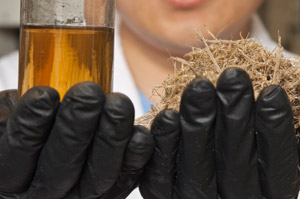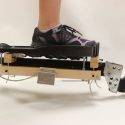University spinoffs represent a new face for agricultural production
Agricultural experts at University of Wisconsin–Madison have long played a key role in a state known for corn, milk and cheese.

Virent Energy System, which employs about 100 people on Madison’s east side, is developing technology to convert plant-derived sugars directly into the major components of gasoline, diesel and jet fuel.
Photo: Andy Manis for Virent Energy Systems
But even as organic farms continue to be one of the hottest sectors of agriculture, a new approach that might be called production biology is evident in high-technology spinoffs related to energy, eggs, ornamentals, feed additives and, of course, to the small-grower market itself.
Spinoffs, defined as companies created by the efforts of UW–Madison faculty, staff or students, include:
Egg innovations LLC. Born during the craze for low-fat, low-cholesterol foods, Egg Innovations got started by licensing patents for discoveries made by founder John Brunnquell while he was getting a master’s in poultry science. Although cholesterol and fat have receded as health issues, “that advantage was very helpful for getting started,” says Brunnquell. “We became the first in the nation to market reduced-cholesterol eggs in compliance with new labeling laws introduced in the early 1990s. Because the technology was developed at a major land-grant university, it gave us credibility I could not bring to the table by myself.” From headquarters in Port Washington, Egg Innovation contracts with farmers who raise half a million free-range, organically fed hens.
Knight Hollow Nursery in Middleton grows half a million tree, shrub, grape and berry plants each year using tissue-culture techniques developed at the UW–Madison botany and horticulture departments. The business started in 1979, when founder and president Deborah McCown was a graduate student. Tissue culture grows plants from a snippet of plant, McCown explains. “You can grow an incredible amount in a very short time. One thing you don’t want to say to a tissue culture nursery is ‘Raise all the plants you can!'” The six employees at Knight Hollow grow approximately 150 types of plants, including 100,000 blueberries and the “Sundance” cranberry, developed by horticulture professor Brent McCown, Deborah’s husband, which the company licenses through WARF.
The idea for Local Dirt, a network linking farmers and markets, arose in 2005, when founder Heather Hilleren was studying at the Wisconsin School of Business. While working at a natural food store, she had seen the difficulty of ordering from small farms. “It was just so time consuming. You’d play phone tag: ‘Do you still have the same product?’ When time was short, it was easier to phone the regional wholesaler.”
Thinking the Web could connect small farmers and stores, restaurants and consumers, Hilleren opened Local Dirt the week she received her MBA. Local Dirt serves tens of thousands of customers and allows farmers to post their own inventory, which is updated as customers place orders. Most of the five employees work on the ever-changing technology, Hilleren says. “We’ve introduced smartphone apps, so if you are at a farmers’ market and find the first asparagus of the season, you can post directly on Facebook.”
Aova Technologies Inc. makes a feed additive that speeds weight gain in livestock and fish. Studies by company founder Mark Cook, a professor of animal science, showed that inhibiting unneeded inflammation in the gastrointestinal tract could improve feed efficiency and suggested that inflammation could be controlled by adding a protein to feed. Tests show that the additive may improve weight gain as much as antibiotics — without the danger of antibiotic resistance. “We make the additive here in Madison, based on eggs grown at a farm in Whitewater, and it’s being used around the world,” says Cook. All six Aova employees were educated at UW–Madison.
Cook, who has several inventions being pursued at Wisconsin companies, says UW–Madison “is an institution that provides us with the freedom to pursue any intellectual ideas we have … if we can find the funding.”
Ideas, Cook says, are the easy part in terms of making a spinoff. “People on campus have thousands of ideas, but to get to the marketplace, you’ve got to find good business leadership.” The business school, he says, is “building up some good young entrepreneurs that allow us to find good leadership to form businesses.”
Dan Olszewski, director of the Weinert Center for Entrepreneurship at the Wisconsin School of Business, sees growing student interest in helping to develop young, innovative companies. “A record number of students are enrolling in the basic entrepreneurship courses. Half of the top 12 places were awarded to recent UW–Madison alums in the 2009 Wisconsin business plan competition.”
Olszewski says he tries to instill realism and a market focus. “Often, people coming from the sciences focused on the technology. It may be a cool technology, but successful business ideas must solve a customer’s problem.”
Change is the only constant, Olszewski adds. “If you are a student now, you have to be prepared for multiple career changes, and training in entrepreneurship gives students enough flexibility to gain some control over their future.”
Olszewski says thousands of people work at university spinoffs in Wisconsin, and the state will continue to benefit from developing the skills and attitudes needed to commercialize the many inventions made at UW–Madison. “The world is made of up of changing industries — you can’t count on the industries that succeeded in the past being successful in the future. Wisconsin has to continually be growing new industries.”
Virent Energy Systems, which employs about 100 people on Madison’s east side, offers a good example of how university-derived technology is changing agriculture by providing a new market for crops. The company is refining catalytic technology to convert plant-derived sugars directly into the major components of gasoline, diesel and jet fuel.
Unlike corn-to-ethanol plants, which use biological fermentation to convert corn into alcohol for supplementing gasoline, Virent is exploring the use of inexpensive catalysts for transforming sugar into conventional fuels.
Catalysts are widely used in industry to accelerate chemical reactions, and company co-founder Randy Cortright had experience with them while working in the oil industry before moving to UW–Madison to get a Ph.D. in the lab of company co-founder James Dumesic.
Dumesic is a professor of chemical and biological engineering and an expert in finding new sources of high-volume industrial chemicals. As Dumesic and Cortright explored the conversion of biomass into fuel, they invented and the Wisconsin Alumni Research Foundation patented catalytic technologies to convert sugar into the basic components of gasoline, diesel and jet fuel.
In 2002, when Virent was formed to commercialize those discoveries, chief technical officer Cortright found WARF’s support critical. “Any number of entities could have come in and swamped us, but because WARF was guarding the intellectual property, we had influence in the industry.”
So much influence, in fact, that Virent has attracted funding and participation from Shell, Honda and Cargill, the giant agricultural processor.
At the root of the company are five patents licensed from WARF and about 15 more that Virent filed for its own inventions.
Virent’s goal is to make a “drop-in” fuel that fits perfectly with the existing infrastructure, Cortright says. “We can make the same molecules that are found in gasoline, jet fuel, diesel, it’s just these are not coming from crude oil, they are coming from carbohydrates, from sugars. We are replacing crude oil, but we are not building new molecules.”
The source of the sugar could be corn or many other forms of waste biomass, says Cortright.
Virent intends to build facilities to prove that its technology can profitably produce the three major fuels; after that, it could decide to license its technology. At the moment, about 85 technical people, more than half of them educated at UW–Madison, are refining the conversion technology and business approach.
As a small player with big plans and potential in a huge industrial realm, Virent “had to develop technology, but also relationships,” says Cortright. “This idea of making a drop-in fuel from biomass crosses a whole variety of industries, from the farm field to the grain elevator and processor. We are at the intersection — with the oil refinery, with the distribution system and with your vehicle.”
Subscribe to Wisconsin Ideas
Want more stories of the Wisconsin Idea in action? Sign-up for our monthly e-newsletter highlighting how Badgers are taking their education and research beyond the boundaries of the classroom to improve lives.


